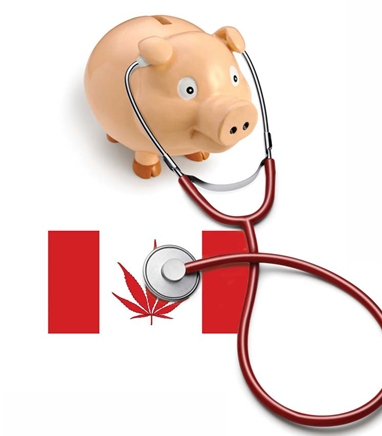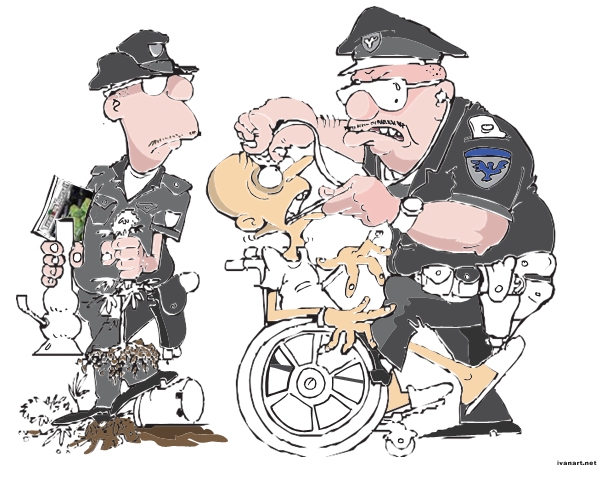
Changes to Health Canada’s Medical Marihuana Program
On June 17, 2011, Health Canada published proposed improvements to Health Canada’s Marihuana Medical Access Program.
An English copy can be obtained at http://www.hc-sc.gc.ca/dhp-mps/consultation/marihuana/_2011/program/consult-eng.php
I am not sure of the link for a French copy.
In reading the consultation document, obtained from the Health Canada Web site, it appears that some beneficial changes are being proposed. It also appears that perhaps some things have been overlooked. Before critiquing each section, I should explain why improvements to this program are important to me.
In 2009, my dearest friend and companion, my wife, was diagnosed with perianal cancer with lymph node involvement. She obtained her authorization to possess medical marijuana from Health Canada, after experiencing the negative effects of OxyContin. Although an OxyContin prescription was easy to obtain and fill, it was problematic to my wife’s health.
The program has failed to meet its intended purpose for six of the 19 months my wife has been a licensed participant of the medical marijuana program. Health Canada has demonstrated little concern, professional ethics, or accountability for this failure. The failure of this pro-gram has caused extreme hardship, anxiety, and needless pain and expense to my wife and family. To my knowledge, the failure has not negatively impacted her doctor, any Health Canada employee, law enforcement official, fire official, or producers.
On the very rare occasion that we were able to speak to Health Canada employees, they often stated it was not the right department, not the policy, or there was an extreme backlog as the excuses for the failure and lack of accountability. Although, we made numer-ous requests and followed
all their procedures regarding supervisor intervention, we were unable to get a return call from a supervisor until we involved our Member of Parliament (M.P.).
After involving M.P., we received a call from Brian and a day later, a call from Gulwant. Both claim to be supervisors for Health Canada; how-ever, neither could address our issues. The third day we received a call from a man named Simon, who also claimed to be a supervisor for Health Canada. This man spent two hours
on the phone with us and stated that he would have responses to our issues within a week.
The next call we received from Health Canada was from Cheryle Anderson. Anderson informed me that Simon was not a supervisor, and that she was responding to my issues. She left no time for us to have a thor-ough conversation, stating she had a meeting to go to. She was unable to access certain information on our account, and we were left with more questions than answers.
After the many deceits and delays perpetrated by Health Canada in regard to the follow-up calls, we again contacted our M.P. We informed our M.P. of every conversa-tion we had had with Health Canada employees, and the many times we’d been deceived by these employees. The M.P. informed but there was lit-tle to do to enforce the ethical behav-ior and accountability of Canadian government employees.
Jeamine Rithot, who stated that she was the director of the medical mari-juana program, next contacted us. During that conversation, she apolo-gized for the failures in the program, cited erroneous information, and was unwilling to answer all of our ques-tions. As the conversation ended, she stated she would respond in writing regarding the conversation. We asked her to e-mail us the response, and she replied she would mail it to us even though there was a pending mail strike: an unexplainable delay in our mind, since emailing and faxing are acceptable forms of communica-tion when placing orders and author-izing payment withdrawals for orders.
Verbal apologies are neither compen-sation nor consolation for the hard-ships caused to licensed participants and their loved ones. Witnessing my wife endure the extreme lack of pro-fessionalism and the inability of Health Canada employees to meet the intended purpose of this program
has prompted me to get involved. It is my sincere hope that my wife’s experiences will not be in vain, and we can effect change to this program that will benefit licensed participants, hopefully, preventing others from enduring the callous disregard of Health Canada. To this end, I have the following concerns with these proposed improvements to the Canadian Medical Marihuana Program.
Section 1.
Introduction. Starting with the very first paragraph, it appears that the participants (and groups representing their interests) may have been the last considered in these revisions. I for one cannot con- sider it coincidental that the first parties mentioned in these revisions in order are: police and law enforcement, fire officials, physicians, municipalities, then program participants and groups representing their interests.
Although the Medical Marihuana Program in Canada has been plagued with problems since its arrival in 2001, many of those problems have affected the participants (prescription holders) directly and far more nega-tively than law enforcement, fire offi-cials, physicians, and even municipal-ities. Had many of the known prob-lems been addressed much sooner, or had marijuana been legalized or decriminalized, there would have been considerably less effect on police and law enforcement, fire officials, physicians, and municipalities.
In the introduction, under the sub-heading “Some of
the key concerns raised include,” it could easily be argued that almost ALL of
the “key concerns” in this section would be eliminated by the
legalization or decriminalization of marijuana. However, the second-to-last
para-graph makes it very clear that this option is not being considered under
these proposed revisions. While the intent of this article is not to promote
the legalization or decriminalization of marijuana, it should be noteworthy that most of the concerns men-tioned would be eliminated if marijuana were to be legalized or decriminalized.
It is important to remember, that this is currently a prescribed treatment for certain conditions. It is important to remember that this program has a lengthy and in-depth licensing proce-dure. It is equally important to rec-ognize numerous problems, such as the length of time to approve a license after a physician prescription has been written, inconsistent shipments to the participants, the lack of accountability from Health Canada employees/supervisors failing to inform prescription holders or even return phone calls, the availability of only one strain of marijuana, as well as limiting the quantity and reorder of this prescribed treatment. These have contributed largely to the key concerns.
It is also noteworthy that the intro-duction does not include a proposed date of implementation for these pro-posed revisions. Indeed, the last para-graph of the introduction essentially informs us that the current flawed process, which has been known and acknowledged to be flawed for quite some time, will remain in effect (pre-sumably indefinitely) until such revi-sions are adopted.
Section 2.
How to Comment on This Document.
I am alarmed that the only way you can comment on this document is pri-vately to Health Canada. Although they provide your choice of options — e-mail, fax, or direct mail — when sending your comments regarding this document of proposed improve-ments, you are still sending them to Health Canada. There’s no mention or option for a public forum for par-ticipants who have experienced other issues not addressed in these propos-als. I believe that participants that
have endured, in some cases for months, without their prescribed medication should definitely com-ment on these proposals. However, I believe that the welfare of the partic-ipant, which is often neglected under the current system, should be the pri-ority for introducing improvements. As such, an independent review board and public forum should be made available to the participants that have been negatively impacted. I believe that it is critical that all situations and possible solutions to provide better, consistent, and affordable health care to those with valid prescriptions and licenses should be con-sidered. With the health care of the participant being the priority concern — or at least it should be — participants should be informed of and awarded the opportunity to comment on the issues expressed by ALL par-ties that wish to comment on this document. It would be nice to know how many people are on the review committee for this document, as well as how many licensed participants are on the reviewing committee.
Section 3.
The Improvements under Consideration.
Reviewing this section, I believe that there should be additional conces-sions and/or implementations to pro-vide authorized, licensed participants a form of expedited intervention, accountability, and compensation in the event that shipments do not arrive in a timely manner or at all. Many licensed participants have experienced firsthand the hardship, undue stress, undue pain, and dimin-ished quality of life that occur when their prescribed pain relief does not arrive on time.
Although Health Canada acknowledges in this section it is “the Program’s intent to provide seriously ill Canadians with reasonable access to a legal source of marihuana for medical purposes,” Health Canada has been directly responsible for many participants not receiving their prescribed medication. Participants that have obtained a doctor’s prescription, a license from Health Canada, filled out the correct order form (in many cases a regular month-ly order), and provided payment to Health Canada have gone months without receiving their order.
The current program provides no form of accountability. Participants are given a sole point-of-contact toll-free number, and even though they request the supervisor’s intervention and are told that a supervisor will call within five business days, as recently as April through June of 2011, we were unable to get a supervisor to call us back without a Member of Parliament’s intervention. When a callback finally came, there was no offer of compensation for the hard-ship caused in the six months that the prescribed medication was not sup-plied, even though they had secured our payment and acknowledged that for six months of a 19 months’ license, no shipment was made. Every excuse was given, from increased participation, licensing delays, backlog in paperwork, and shipping. We were told by the Director of Medical Marihuana Program for Health Canada that Health Canada offers no compensa-tion and all she could do was apolo-gize.
Although the Canadian government employs the employees of this pro-gram, it is still a business that takes money to provide a service. If the Canadian government can operate with no accountability to paying licensed participants, how much easi-er will it be for the private sector to avoid accountability for delayed and missed shipments? I believe many participants would agree it is impera-tive to address the issues of expedited intervention, accountability, and just compensation before implementing changes or improvements. I believe any participant that has experienced this would agree that delayed and missed shipments undermined the quoted intent of the program, which once again is “the Program’s intent to provide seriously ill Canadians with reasonable access to a legal source of marihuana for medical purposes.”
Section 4.
How the Proposed Redesigned Program Would Work.
4.1 Physician-Patient Interaction An important consideration that should be included in this section is the influence of the various governing bodies of doctors. In Alberta, for example, the College of Physicians and Surgeons recommends that doc-tors not sign medical marijuana forms. Personal experience has demonstrated this has a dramatic and negative effect on participants that have an ongoing condition and a pre-vious license. We personally experi-enced this dramatic and negative effect after relocating our residence. The doctor we began seeing in our new town was aware of my wife’s condition and marijuana prescription well before her renewal date. When it came time to have her renewal doc-ument signed, the doctor, although supportive of her renewal, refused to sign her documents. He stated that before he could sign, he would have to discuss the matter with the College of Physicians and Surgeons of Alberta. We had to make a second appointment, only to find out that the College of Physicians and Surgeons recommended that no doc-tor sign the medical marijuana docu-ments. At that time, we contacted the College of Physicians and Surgeons of Alberta, and were informed that this was actually post-ed on their Web site. (I have not veri-fied if this is still on their Web site, but it was there in October 2010.)
With all of the drugs that have been recalled after being approved for use by the College of Physicians and Surgeons, this federally authorized program is being correctly under-mined. Since the governing body for doctors is the College of Physicians
and Surgeons, it appears they have more weight authorizing doctors to sign (at least in the doctor’s opinion) than the federal government. Although I’m not sure of the advice given to doctors in each province, this issue can lead to difficulties in obtain-ing the proper authorization and/or renewals for participants. Failure to address this very critical detail will guarantee the failure of the proposed improvements and the future avail-ability of this program.
4.2 Dried Marihuana Production and Distribution
This section has ten bullet points, and although they’re not numbered, I’m going to address each bullet. Some of these bullets are obviously good improvements beneficial to the par-ticipants, while others require some adjustment, in my opinion.
*Health Canada has routinely demonstrated its inability, inconsis-tency, and lack of accountability in supplying and distributing marijuana to licensed participants — even the participants that have diligently fol-lowed their policies and procedures. Removing Health Canada from the distribution of marijuana to partici-pants is a step in the right direction. With proper legislation, participants’ health and well-being will be better served.
*Having commercial producers will provide participants with effective options to a higher quality and diver-sity of medical marijuana. However, it is time for Canada to recognize the many ways in which marijuana can be consumed, and to that end, com-mercial producers should also be able to produce and distribute edible mar-ijuana products to licensed partici-pants also. Edible products effective-ly eliminate any arguments regarding the negative impacts of inhaling mar-ijuana.
*This bullet needs to be re-thought.
Individuals should be able to grow their own marijuana for medical pur-poses.
Certain limitations and regu-
lations regarding the amount of plants and the location of where plants can be grown (i.e. indoors) could be expected. Additional limita-tions could be imposed to prevent indoor growing by rental tenants, and restricted to only the property holder, these individual growing loca-tions to be inspected by the same inspectors monitoring the commer-cial grows. This would eliminate potential electrical safety issues, fire safety issues, and mold-producing issues, such as inadequate venting. To totally remove the option for indi-viduals to grow their own medical marijuana overlooks the financial savings that directly benefit these
individuals. It is legal, for example, to make alcohol in your home. The byproduct of the improperly made alcohol can cause blindness, while the byproduct of improperly grown mar-ijuana is inferior marijuana. This bullet really needs to be re-thought, especially if there is no regulation controlling the end cost of commer-cially grown medical marijuana to the licensed participant.
*This bullet deals with compliance and requirements for licensed com-mercial producers. With the welfare of licensed participants being the focus of this program, high standards and quality control are good things. However, more information needs to be presented by Health Canada for the requirements of personnel, security, and disposal to effectively evaluate this bullet.
*As it reads, this bullet concerns the regular audits and inspections for licensed commercial producers. However, the first portion of this sen-tence requires more information before anyone can comment on the value of this bullet to licensed partic-ipants. The sentence starts, “Health Canada would establish a compre-hensive compliance and enforcement regime.” Without a written defini-tion of this proposed regime, how can Health Canada expect licensed participants to comment on these proposed improvements by July 31, 2011? To expect the licensed partici-pant on such a short timeline, one would expect that the licensed partic-ipant would like to see all the docu-ments on the proposed improvements before commenting.
*This sixth bullet is conflictedly alarming, in my opinion. I believe that all licensed participants would agree that commercially purchased medical marijuana should have spe-cific product labeling and packaging requirements. However, I believe that a licensed participant of the med-ical marijuana program, with a Canadian doctor’s prescription, should not be required to prove the legitimacy of their marijuana. Licensed participants should only be required to prove that they are licensed and seeing a legitimate doc-tor.
*This bullet limits commercial pro-ducers to growing indoors; this is an effective method of controlling the quality of marijuana, security, and safety of commercial producers. *This bullet allows licensed commer-cial producers to produce any strain of medical marijuana. Most licensed participants will agree this is a great improvement. This same opportuni-ty should be available to individuals that wish to grow their own medical marijuana.
*This ninth bullet should be of par-ticular importance to licensed partici-pants of the medical marijuana pro-gram. Licensed participants on a fixed income, or located in financial-ly restricted communities, or those participants unable to declare med-ical marijuana as an insured prescrip-tion, should not be exposed to poten-tially inflated prices of their medical marijuana. Although Health Canada was inconsistent with its ability to supply participants in a timely man-ner, the medical marijuana was at least affordable. Even though com-mercial producers can produce whichever strain of medical marijua-na they choose, it is still a plant. There’s no difference in the growing process of different strains. By allow-ing commercial producers to set their own price, you open the door to the “risk of abuse and exploitation by criminal elements.”
Currently, there are a number of compassion houses assisting medical marijuana participants in obtaining medical marijuana. The prices med-ical marijuana participants pay at these compassion houses rival street prices. In actuality, a recent compar-ison of street prices in Edmonton, Alberta, showed they were equal to the prices charged at compassion houses, with compassion houses charging an additional cost for ship-ping. This effectively means you can purchase marijuana cheaper from the criminal elements than you can from a compassionate house. The price difference was $100 more for two grams less, when compared to Health Canada. Note that the strain offered by Health Canada was inferior in comparison to the strain being sold by the compassion house (both street suppliers and compassion house were selling the same strain).
Allowing commercial producers to set their own price
overlooks that this (medical marijuana) is a quality-of-life alternative
medicine, and as such lumps marijuana in the same category as consumer goods
like alcohol. If indeed the intent of the program is “to provide seriously
ill Canadians
with reasonable access to a legal source of marihuana for medical pur-poses,” it must be price regulated.
*The final bullet of this section states that a licensed commercial producer will only be able to send the tried marijuana they cultivate by registered mail or bonded courier. This protects both the licensed commercial produc-er and the licensed participant, and is undisputedly a good idea. I do believe, as I’ve stated earlier, that Canada needs to acknowledge the various methods in which marijuana can be consumed, especially since the production of quality edible products would assist with the disposal of plant trimmings, an issue commercial pro-ducers must deal with. Assuming that Canada is seriously pursuing improvements to the medical marijua-na program, edibles should be consid-ered and should be permitted to ship by registered mail or bonded courier.
Section 5. Impact on Current Program Participants Holding an Authorization to Possess Marihuana for Medical Purposes.
This section contains five paragraphs. Although paragraphs three and four, as written in the consultation docu-ment, would appear to make the licensing process and supply of med-ical marijuana to licensed participants easier, paragraphs one and two should send up a red flag to any licensed participant.
Without addressing the previously mentioned concern of the
influence that the College of Physicians and Surgeons has over doctors, and
influ-ence that could hinder the intent of the program and/or the licensing
process, it would appear from this whole document, not just this section, that
Health Canada is relying on the medical community to be objective and
supportive of the medical mari-juana program. This should be par-ticularly
alarming to licensed partici-
pants currently holding an authoriza-tion to possess marijuana for medical purposes.
The medical community, mainly doc-tors, has historically not been objec-tive about or supportive of holistic medicine and alternative remedies. Indeed, historically, the medical com-munity has got behind and supported new drugs, only to witness those drugs be recalled due to the devastat-ing side effects and complications they cause. Although these dangerous drugs were promoted and prescribed by physicians, very few physicians suffered any negative effect from the promotion of these drugs. If only the same could be said of the patients that suffered through the side effects and complications caused by taking these drugs that were prescribed by a med-ical authority!
In addition to these recalled danger-ous drugs, physicians routinely pre-scribe potentially addictive pain med-ication quite liberally to seriously ill Canadians. Since each patient responds differently to prescribed medications, patients that experience negative effects from a prescribed drug return to their medical authority only to receive a different prescribed
drug. Drugs like morphine, OxyContin, and Vicodin (to name only a few), while they help control pain, are addictive and habit forming. Law enforcement can substantiate that these prescription drugs have become part of an ever-growing list of problem street drugs. In addition to being habit forming, the use of these drugs can inhibit the quality of life of the patient.
Section 6.
Impact on Current Program Participants Who Hold a Personal-Use or Designated-Person Production License.
This section reiterates the intent to only permit commercial producers the right to grow medical marijuana, denying individuals that cost-effective option to grow their own medical marijuana. I’ve already expressed why I feel this is a concern for license participants.
However, at this time, I would like to quote the last sentence of this section. The last sentence reads, “A detailed transition plan will be shared with stakeholders when proposed regula-tions are pre-published in Canada Gazette, Part I.”
Health Canada acknowledges with this sentence that a detailed transition plan is not available for consideration or comment at this time. However, Health Canada expects stakeholders to comment on this consultation doc-ument individually and intelligently by July 31, 2011, presumably to develop those details. I believe this emphasizes the fundamental problem with legislation regarding the medical marijuana program in Canada.
The Canadian medical marijuana program was designed to benefit seri-ously ill Canadians. This program was not designed to benefit law enforcement, fire officials, physicians, municipalities, commercial produc-ers, or even Health Canada. The majority of licensed participants would agree there is no benefit in encouraging the criminal production and distribution of marijuana, IF a program existed in which seriously ill Canadians got this form of pain relief as quickly and easily as prescribed drugs like OxyContin.
Remembering the program’s intent is
to provide seriously ill Canadians with reasonable access to a legal
source of marijuana for medical pur-poses means this program IS intended to benefit seriously ill Canadians. As such, an independent committee con-sisting of a majority of licensed par-ticipants, one high-ranking federal law enforcement representative, two representatives of the medical com-munity that are openly supportive of medical marijuana, and one openly supportive representative from each political party should be convened to review any proposed improvements to this existing program. This com-mittee should be responsible for reviewing and developing detailed improvements that could then be leg-islated.
Only persons openly supportive of the medical marijuana program, and licensed participants, will be focused on improving this flawed program to the benefit of seriously ill Canadians.
After all, in the 10 years this program has been in place,
it is the licensed participants (seriously ill Canadians) that have been most
negatively affect-ed by the flaws in this program. This is not only a
noteworthy statement, it is the whole reason for proposed improvements in the
first place. This is why the majority of the independ-ent committee should be
licensed par-ticipants.
Section 7.
Opportunity for Those
Interested in Becoming
a Licensed Commercial
Producer.
This section should not even be men-tioned in this document until details are established related to reach sub-heading. The subheadings are: dried marihuana production; distribution and disposition; personnel; record-keeping and Reporting; and compli-ance and enforcement.
Summary
Again, I would like to emphasize that the intended purpose of the medical marijuana program is to provide seri-ously ill Canadians with a legal source of marijuana for medical pur-poses. With this in mind, the licensed participants’ welfare, including affordable medical marijuana, should be the number-one priority of all improvements.
The current proposals suggest that no license will be issued by Health Canada. Instead, the application would go to a commercial grower. This will make it extremely difficult to order from a different commercial grower, should the initial grower be unable to deliver in a timely manner. Worse, there is no mention or consid-eration of Health Canada’s repeated inability to deliver medical marijuana in a timely manner, or how a licensed participant will deal with these issues once the program is essentially priva-tized. It does not address the unethi-cal business practices exhibited by Health Canada, or how those issues will be escalated currently or once this program is essentially privatized. Having personally witnessed the openly unsupportive influence of the medical community, I would serious-ly question the medical community having so much control in this pro-gram, especially when no details or review committees containing licensed participants have been established. Although it would
appear initially to be an improve-ment to the currently flawed pro-gram, I can see this negative influ-ence leading to the demise of the entire program down the road. Although I am extremely confident that our experiences are not unique, I would recommend that anyone responding to this consultation doc-ument should include a brief history of their negative experiences, as we have below.
I personally witnessed my wife dete-riorate before me in
the one month that she was on OxyContin. My beautiful six-foot-two and
140-pound wife completely lost the ambition to live. During the month that she
took OxyContin for pain relief of perianal cancer, she lost over 25 pounds.
Although she had no pain, she also had no life. After taking the prescribed
OxyContin, she would become lethargic and unable to focus on the simplest
things. She would watch TV for an hour and be unable to tell you what she just
watched. Her doctor attrib-uted it to stress and depression from
being diagnosed with cancer, and prescribed antidepressants to be taken with the OxyContin.
After one week of marijuana use, my wife completely stopped taking OxyContin. She began to put on weight and remember the details of her day. Although marijuana pro-vided considerably less pain relief, it made the pain and discomfort toler-able, allowing her to function and have some quality of life. My wife has never exhibited any “couch potato” symptoms stereotypically assumed to be associated with mar-ijuana use. Indeed, her authoriza-tion to possess medical marijuana has removed the need for secrecy and allowed her a more active life. She has no reason to hide out while inhaling the marijuana, nor a need to hide out and conceal the effects of inhaling the marijuana.
Even after obtaining the proper and legal authorization to
possess med-ical marijuana, the expressed intent of the medical marijuana
program to provide a legal source of marijua-
na for medical purposes, my wife was unable to obtain through legal sources her medical marijuana for six months of her 19 months’ license.
Amazingly, in 2011, it is still easier (and will remain easier if these improvements are adopted) for seri-ously ill Canadians to get a pre-scription (with multiple refills) for highly addictive OxyContin, with-out government intervention, than it is to get authorization to consume a plant that grows naturally.
Perhaps if the doctors had witnessed what I witnessed, they would all be more objective and supportive of the medical marijuana program. Perhaps if the doctors had witnessed what I witnessed, they would final-ly acknowledge that the positive effects of marijuana outweigh the expressed concerns of the medical community. Remember, we’re talk-ing about a plant. Unlike other commercially promoted plants and herbs, the users of this plant can verify it works on their own.
After all, with hundreds of thousands in North America alone over the last 55 years, what other drug has had as extensive human trials with fewer negative effects than marijuana? If marijuana were half as bad as the medical community would like you to believe, the population in North America should be half of what it is.








